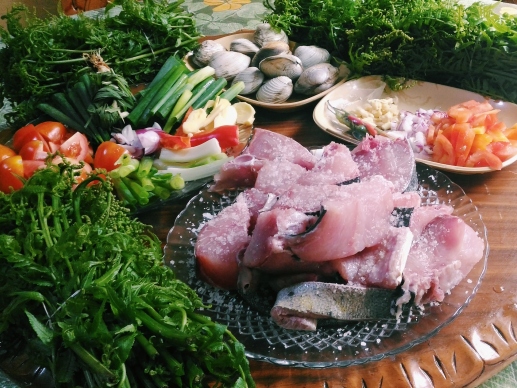Fish tinola (soup) has and always been a staple dish on every Filipino dining table. For a country surrounded by the sea, fish are abundant and freshly caught fish can be easily acquired. The simplest and easiest way to cook freshly caught fish is tinola (or tinuwa in Cebuano). It’s basically fish cooked in water added with lemon grass, tomatoes, moringa leaves, onions and spring onions! Simple isn’t it? In Luzon and the Tagalog regions, their popular method of cooking fish soup is sinigang (sour soup). Traditionally, they would use tamarind to make the broth sour. In the Visayas regions, they would use iba or kamias or bilimbi.
My fondest memory of fish tinola was that my father and I would go to the beach in our area early in the morning, especially in the weekends (we live relatively close to the sea), and wait for local fishermen to arrive with their catch for the day. In the rural areas, this practice is called manabo ( from the rootword “tabo” or “to meet”). We would then help them bring their small outrigger boats to the shore and inquire on the day’s catch and buy a kilo or two depending on the type of fish. It’s also a good way to take a morning dip at the beach and bring some fish to cook when we get home. It’s cheaper to do it that way than go to the fish market because the price would be relatively higher since the fish vendors would add profit from it. The marginal fishermen would often opt for it since they no longer need to bring their catch to the markets or sell it to middlemen. They can also be assured that their catch are immediately sold, hence they do not need to buy ice to keep the fish from spoiling. However, some fishermen tend to sell the fish themselves in the market (some 20 kilometers) or sell it to the fishmongers if they have 10 or more kilos of fish caught.

Once we already have the fish and we get home, my father would then prepare the fish (cleaning, gutting, slicing if need be). He would then ask me to get some moringa leaves, lemon grass, and spring onions from our backyard. By 11 a.m. the smell of the tinuwa is already lingering in the air and signalling that it’s almost lunch time — happy days!
Anyways, through the years I have cooked and tasted many kinds of tinuwa and sinigang and I have came to acquire my own style of cooking fish soup.
So, here is my version of the ubiquitous Filipino comfort food — tinolang isda (fish soup). Ingredients and procedure to follow :
Ingredients:
3/4 kilo fish (preferably the bigger ones) — I prefer to use the giant trevally (mamsa) or any large fish
2 bundles spring onions (cut into 2 inches long)
3 pcs. red tomatoes (cut into quarters)
1 stalk lemon grass (tangad)
1 bulb onion (roughly chopped)
1 red pepper (coarsely chopped)
10-15 pieces mangrove clams (imbao) or any clam you like (clean the shell and let it drain)
small ginger (coarsely chopped)
2 small sachets of Sinigang sa sampalok mix
salt
1 1/4 liters of water
1 cup lukot or eggs of Dolabella auricularia
Procedure:
- Clean the fish thoroughly making sure that all the blood are cleaned from the flesh. Drain excess water and rub 3 tablespoons of salt to the fish.
- Add the tomatoes, lemon grass, ginger, red pepper, onions in the 1 1/4 liter of water and bring them to a boil.
- Once the water already boiled, add the fish and lower the heat.
- Simmer for 10 minutes.
- Add the spring onions and the mangrove clams.
- Simmer for another 5-6 minutes.
- Add the Sinigang sa Sampalok mix and adjust according to taste.
- Add salt according to taste.
- Add the lukot 1 minute before your soup is done.
- Serve and enjoy with rice and don’t forget to add one or two chili peppers on your soup!
Note: I also included the fern salad or pako salad. I’ll be posting this simple recipe soon.



PAKO SALAD (FERN SALAD)
Now this one is rather simple to prepare. All you need to do is to chop up all the ingredients then add vinegar and salt.
4 bundles of freshwater fern (can be bought in any market in the Philippines although I doubt this is available in Supermarkets)
3-4 tomatoes
ginger
red onion
vinegar
salt to taste
black pepper
dried small anchovies
spring onions
Procedure:
- Clean the fern leaves with water but not thoroughly as they are brittle.
- With a knife, take out the tops of the stalk and all the leaves. If the stalk snaps, it’s still good to eat but when you try to snap the stalk and it’s springy, then it’s already mature and not suitable to be eaten. You must have patience in doing this since there are approximately 40 to 50 stalks in a bundle. My guess for every bundle, you only get 1 or 2 cups of the the fern salad.
- Slice the tomatoes, onions, ginger and set aside
- Pan fry the dried anchovies until crispy.
- Heat water in a pan.
- Once you see that the water is warm enough, put in the ferns. Wait until the water is boiling then turn off the heat and drain the water.
- In a caserole, put the fern then add in the sliced tomatoes, ginger, and onions. Add the fried anchovies on top.
- Dissolve a tablespoon of salt in 1 cup of vinegar. Adjust according to taste then add it to the salad.
- Finally, sprinkle with chopped spring onions. Enjoy!



